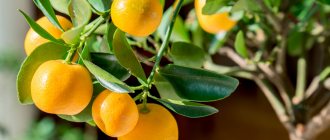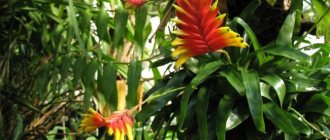Calamondin what is it
The cute potted plant Calamondin was created by crossing a tangerine and a kumquat. And if the tangerine is familiar to us from childhood, then the kumquat is a representative of citrus fruits that looks like a small, elongated tangerine.
Calamondin or citrofortunella adapts well and bears fruit at home. Calamodin varieties are hybrids that are adapted for growing at home. The plant belongs to the Rutov family. Characteristic features of calamondin:
- home tree up to 1.2 m in size (there are smaller, dwarf varieties);
- leaves are simple, with a glossy shine, oval in shape;
- large flower buds reach 2.5 cm;
- the calamondin flower resembles five-lobed “stars” that emit a pleasant citrus aroma;
- characterized by self-pollination and the formation of a large number of ovaries;
- domestic, small fruits (10-15 g) resemble round tangerines.
Calamondin begins to bear fruit 2-3 years after planting. Dwarf citrus forms a dome-shaped crown, abundantly covered with shiny foliage, between which orange fruits peek out.
The plant is native to Southeast Asia, where it grows naturally. In nature, the calamondina tree reaches 7 m in height and bears fruit abundantly all year round, supplying the local population with edible fruits.
Can calamondin fruits be eaten?
If a calamondin tree has just been purchased and is hung with orange tangerines, then it is better not to eat them. For decoration and protection from pests and diseases, calamondin undergoes repeated treatment with chemicals in greenhouses where it is grown for sale.
Home-ripened citrus fruits are quite edible. Calamondin mandarins have a specific, sweet and sour taste with a slight bitterness. Unfortunately, citrus fruits contain a lot of seeds and organic acids, so fruit experts recommend eating them directly with the peel.
It’s good if household members like this citrus taste: the number of homemade fruits allows you to enjoy them from time to time. Ripe tangerine fruits are cut from the branches and eaten, calamodin jam or other sweet dish is prepared, and stored in a cool place.
With proper care, citrus flowering and fruiting continues all year round. It’s a common thing when “white stars” bloom on a home tree at the same time and the orange balls of tangerines are pleasing to the eye. But there are certain varieties that bear fruit seasonally.
Appearance and taste of fruits
Calamondin is a hybrid of mandarin and kumquat. We have been familiar with tangerines since childhood, but the kumquat, or rather its fruits, appeared in our country only a few years ago. You can find it on supermarket shelves with exotic fruits. In appearance, the kumquat is very similar to the lemons and oranges we are used to - the same porous yellow-orange peel and juicy pulp, but the fruits are smaller than tangerines and have an oval shape.
From the kumquat, the calamondin got the size of the fruit - small, no larger than a walnut, weighing 10-15 grams, but it inherited the shape and color of the fruit from another “parent” - the tangerine.
Calamondin fruits are edible, their taste is very pleasant - sweet and sour with a slight bitterness. Experts recommend eating the whole fruit, along with the sweet peel.
Calamondin fruit
However, you should not eat or even try fruits from plants that are on store shelves or purchased recently: in order to maintain their fruit-bearing appearance, they are subjected to repeated chemical treatment.
Various desserts, preserves, jams are prepared from calamondin fruits, and are also used to make sauces and seasonings.
Calamondin care at home
The exotic tree is perfect for “living” at home. Moreover, both experienced gardeners and beginners can grow calamondin. The combination of the visual attractiveness of citrus with unpretentiousness, high yield and edible fruits pleases and delights residents of middle and northern latitudes.
Soil and drainage
Two weeks after purchase, the calamondin plant needs to be transplanted “to a permanent place of residence.” Replanting a houseplant is easy using step-by-step instructions:
- Buy an earthen mixture for citrus fruits, which is a nutritious and loose substrate.
- For calamondin citrus, purchase a clay or wooden pot that is 3-4 cm in diameter larger than the original container. The diameter of the pot depends on the volume of the plant's root system. Plastic containers are also used, which provide good drainage.
- When transshipping, consider the condition of the citrus root system and remove dried and rotten roots.
- Remove the fruits and shorten the branches so that the citrus will take root better. The fruits of calamondin and the leafy ground part absorb nutrients, causing the fragile tree to get sick.
- Place drainage at the bottom of the pot. A 2-3 cm thick layer of expanded clay, pebbles and broken bricks will protect the root system from rotting. Citrus trees love moist soil, but stagnant water is detrimental to them.
- Drainage, a layer of soil, and the roots of the tree are placed in the pot in layers and covered with nutrient substrate. The soil is lightly compacted, leaving a distance of 3-5 cm from the edge of the pot for easy watering of homemade citrus.
- After transplantation, calamondin is watered and not fed for a month, since there are enough nutrients in the soil.
Sometimes after transplantation, calamondin sheds its leaves. This is a temporary phenomenon. With proper care, young shoots subsequently appear, the plant actively grows, restoring its appearance.
Lighting requirements
Citrofortunella calamondin feels good on the eastern and southeastern sides of the house, as well as on a balcony or loggia where there is diffused lighting. When placing near a south window, it is advisable to cover the glass with light-protective film. The domestic calamondin tree does not tolerate direct sunlight. This is especially noticeable in the heat, when brown spots from sunburn appear on citrus leaves.
Citrus will not bear fruit if daylight hours are significantly reduced. If the grower is committed to year-round fruiting of calamondin, then lighting is important so that daylight hours last 10-12 hours.
It is not advisable to frequently move the pot. The Citrofortunella tree is quite capricious in terms of habitat. It takes root in one place and does not tolerate change. To ensure uniform growth of shoots and a round crown, it is advisable to rotate homemade calamondin clockwise by 10-15 degrees per week.
Microclimate
For calamondin citrus, it is important to maintain the temperature in the range from +23 to +26C. There should be no strong differences between day and night temperatures. In winter, the optimal temperature is +12-+18C, if the houseplant is resting and does not bear fruit. After a period of dormancy, flowering and fruiting will be abundant.
Homemade citrofortunella does not like stagnant, “heavy” air. Ventilation is important, but without drafts and cold air currents. Reducing the temperature level to +2 - + 3C is dangerous for a tree called calamondin.
The temperature of the soil of the roots and the upper part of the citrus should be approximately the same. If the house has heated floors, then you need to lift the plant onto a stand. In summer, it is advisable to wrap the pot in white paper so that it does not overheat.
Watering and spraying
Since the domestic calamondin comes from the tropics, it is a big fan of humid climates. In order for the tree to feel good in the apartment, watering the plant is important:
- Watering is carried out constantly so that the earthen ball does not dry out.
- Use settled, “soft” water at room temperature.
- After watering, drain the water from the pan to avoid rotting of the roots.
- The plant is sprayed a couple of times a week with a spray bottle and, if possible, the leaves of the tree are wiped from dust.
- Central heating dries out the air greatly, so in the room with the home calamondin, they install humidifiers, put water in trays or containers, and hang wet towels on the radiators.
If a homemade citrus tree has dried out, it can not only shed all its leaves, but also die. Soil and environmental moisture is an important condition for the active life of a plant.
There are not so many varieties of calamondin, you can count them on your fingers. Among others, calamondin variegata with variegated foliage stands out. The milky spots look unusual against the background of bright green foliage. The Senteniel variety is a variegated variety. The varieties Meiva and Margarita have the most delicious fruits.
Feeding and fertilizers
From spring to autumn, during the active growing season, homemade calamondin needs additional nutrition. It is fed twice a month with complex formulations for citrus fruits. In winter, it is enough to fertilize the tree once a month. Foliar spraying of microfertilizers on the leaf is useful.
Homemade calamondin loves succinic acid supplements, but treatment with this drug must be carried out carefully, after reading the instructions. The plant is not indifferent to fertilizing based on banana peels. A combination of different ways to feed your homemade calamondin will definitely bear fruit. The citrus tree will delight the owner with abundant flowering and fruiting.
Crown formation
When the “pet” grows to 25 cm, the formation of a rounded crown begins to give the plant a well-groomed, neat appearance. Calamondin pruning is carried out from mid-February to mid-summer. Subsequence:
- First, the upper shoots are pruned;
- shorten the branches of the middle part;
- pinch the top when the calamondin has reached the desired height.
Pruning the main branches encourages side branch growth, which creates a fuller, leafier citrus canopy that doesn't have side branches sticking out. They also remove shoots that do not grow fruit for the second year in a row.
Hygienic pruning of home citrus is also important, which is carried out as needed. At the same time, dried, crooked branches that stand out from the overall symmetry are removed. The total increase should be no more than 30% per year.
To make homemade kalamodnin feel like it’s in the tropics and get sick less, they use the grafting method. A strong orange seedling is used as a rootstock. Calamondin grafting is carried out by an experienced grower with practical skills.
Flowering and dormant period
Homemade citrus looks the same throughout the year. There are varieties of kalamodin that consistently bear fruit all year round. Others require a period of rest or a period of rest in order to gain strength for active growth, flowering, and fruiting. The period of active life of citrus occurs in spring and summer.
It is advisable to move calamondin into a room with a temperature of up to +18C in the autumn. Diffused light, watering, and occasional fertilizing will help the houseplant prepare for the next growing season. And in the summer, to the joy of flower growers over the ripened, orange fruits of tangerines, the delicate aroma of flowers is mixed.
Transplanting a plant
The large root system of citrus calamodnina needs a lot of space, so transplants are necessary. Action algorithm:
- Young trees are replanted annually in the spring, adults - once every 2-3 years.
- Calamondin transplantation is carried out using the transshipment method while maintaining the integrity of the earthen coma.
- Prepare a new pot 5-8 cm larger than the volume of the root system.
- The neck of the citrus is not buried, leaving it at the same level.
- A large calamodin tree is not replanted, changing only the top layer of soil.
When transshipping, it is extremely undesirable to expose the root system of citrus. Saprophytic fungi live on the roots of calamondin, which support the plant’s living environment. When old soil is removed, microorganisms die and the tree becomes sick.
Winter maintenance and temperature conditions
Despite the fact that the plant is frost-resistant, it is better to grow it in warm conditions, at a temperature of 20-250C, with air humidity of about 70%. Citrus does not tolerate extreme heat, as well as extremely low temperatures. The roots and crown of the tree must be in the same temperature conditions. If the temperature in the root system zone is lower than in the crown zone, the roots will not have time to absorb moisture, otherwise the roots will absorb too much of it. Such a difference will lead to plant stress and leaf loss.
If the roots absorb a large amount of moisture that the leaves cannot absorb, dropsy will develop: hard growths will appear on the underside of the leaf. After this disease, the appearance of the leaves is not restored.
In winter, in order for the tree to rest, it is removed to a room (loggia or greenhouse) with a temperature of 10 - 150C. When wintering in a warm apartment, the window sill is fenced off from the room with a thick film so that the required temperature is established inside. The holiday lasts from November to mid-February. By the beginning of March, the plant wakes up. After spending the winter in a dormant state, the tree begins to actively grow and bear fruit. In the absence of a cool winter, indoor calamondin lives no more than 4 years, quickly depletes and dies.
Homemade citrus begins to bloom in early spring and bears fruit at the end of September. Fruit ripening lasts 5-9 months. The fruits can hang on the tree until the next harvest.
Reproduction of citrus calamondin
Lemon calamondin does not live long: its life expectancy is 5-6 years. But don't despair. There are ways to propagate exotic citrus that will restore a green garden in your apartment.
Seeds
There are several ways to propagate domestic calamondin. Growing a plant from a seed, which is extracted from a well-ripened fruit. The citrus seed is planted in the soil to a depth of 1 cm and waited a month until the sprout appears.
The disadvantages of the method include the long wait for the first calamondin fruits, which will appear after several years. A tree grown from seeds may not enter the fruiting period at all. It is up to the grower to decide whether to use this method or not.
By cuttings
Obtaining citrus from cuttings is the optimal method of propagation. The process of cutting calamondin is carried out as follows:
- Select a branch located closer to the top of the crown, on which there are 2-3 buds. Cut it with a sharp knife at an angle.
- Place it in a stimulant solution - “Epin”, “Zircon”, “Kornevin” for a day.
- Then the citrus is planted in a pot with soil and covered with a jar (polyethylene), creating a home mini-greenhouse. Choose a bright place to place it.
- With sufficient humidity and light, and a temperature of +25°C, the roots of the future calamondin appear in 2-3 weeks.
- A month later, the young calamondin is transplanted into a pot for further rooting and growth.
In the second year of growth, the first tangerine fruits appear, while the varietal qualities of homemade citrus are completely preserved.
Vaccination
This method is available only to experienced flower growers who have mastered the grafting procedure in practice. Its sequence:
- use an adult tangerine plant as a rootstock;
- cut off its entire upper part, leaving a stump 8-10 cm high;
- an incision is made in the hemp in the center;
- a sprig of domestic calamondin is inserted into the incision;
- the twig is fixed with adhesive tape;
- the scion and rootstock are covered with film for a month, creating a humid atmosphere;
- two months later, when the scion has taken root, remove the fixing tape.
The method is good in all respects. Thanks to this method, a strong citrus plant grows, which adapts well to apartment conditions and rarely gets sick.
Transplanting calamondin after purchase
After purchase, young individuals of calamondin require replanting, since the peat soil in which the plant was sold dries out quickly, and the roots entwined in the ball are overheated. At an early age, citrofortunella is replanted every year, since the root system of the tree develops quickly. Adults are transplanted every 3-4 years. Large trees are not replanted, but only the top layer of soil is replaced.
For replanting, you will need a large, capacious pot, since, despite its compact size, this crop has a wide, branched root system.
The tree is replanted by careful handling, without changing the soil or washing the roots. A mixture of peat, turf and leaf soil, sand, and manure humus is used as planting soil. A high layer of drainage is made at the bottom of the pot. The soil mixture should be slightly acidic or neutral. You can take ready-made soil for citrus crops. Before use, the substrate is subjected to heat treatment to destroy the larvae of various pests, bacteria and fungi.
You need to loosen the soil very carefully so as not to damage the root system.
Diseases and pests of citrofortunella
Homemade citrus calamondin suffers from pests and diseases if not properly cared for. When a tree is weakened, it is attacked by pests: scale insects and spider mites, whiteflies and aphids. At home, it is safer to use traditional methods of struggle:
- The foliage is wiped with a damp cloth soaked in a solution of green or laundry soap. The interval between procedures is a week if the pests continue to “attack.”
- Calamondin foliage is treated with soap-oil emulsions. To prepare them, add a spoonful of machine or burdock oil to a liter of soapy water.
- Citrus is saved from aphids by tar soap, which is diluted in a ratio of 10 g per liter of water.
If domestic citrofortunella is severely affected, then “chemistry” cannot be avoided. Use “Fitosporin”, “Calypso”, “Fitoverm”, observing precautions when working with drugs. Citrus calamondin does not bypass a number of diseases:
- Anthracnose is when brown spots appear on leaves or stems. They gradually dry out, the foliage falls off, and “holes” or cracks appear on the stems, which interfere with the movement of plant sap through the vessels. If the humidity is high, then rotting processes are observed. Rescue drugs - “Fitosporin M” or 1% solution of Bordeaux mixture. Affected areas of calamondin are cut off and burned.
- Sooty fungus is a product of the scale insect. Sticky plaque disrupts the respiration and photosynthesis of the citrus leaf. The appearance of the tree also suffers, losing its attractiveness. Black plaque is removed with a cloth soaked in warm water.
- Gommosis appears as cracks on the calamondin trunk, from which yellow, sticky droplets are released that harden in the air. This is gum disease, the cause of which is excess nitrogen in the soil. The gum is removed and the wound is cleaned, after which it is disinfected with a solution of potassium permanganate and covered with garden varnish.
It happens that the domestic citrus calamondin suddenly drops its leaves. There are quite a few reasons for this phenomenon: draft, placement next to heating devices, high temperature, low humidity, rotting roots. Having discovered the cause and eliminated it, you will have to wait until the citrus tree gives new shoots and begins to grow.
Homemade calamondin or a plant with the complex name citrofortunella decorates our homes and apartments with bright balls of tangerines, gives a delicate floral aroma, creates a positive mood and evokes thoughts of tropical countries. And a small citrus garden wraps the house with essential oils, which give a boost of energy and destroy some bacteria. So why not get such a cute and elegant citrus?
Common Pests
Tabernaemontana.
formation, flowering, reproduction, home care Despite the spicy smell, pests do not ignore calamondin. Flower growers have to deal with most pests. The most common insects are collected in the table.
Table - Calamondin pests
| Pest name | Signs of appearance | Ways to fight |
| Spider mite | — Leaves look dusty; - the tree sheds its leaves; - branches are covered with a thin cobweb | — Increased air humidity; — at the first signs, treatment with systemic insecticides (“Aktellik”, “Aktara”, “Inta-vir”) |
| Shchitovka | — Plaques form on the stems and leaves; - leaves turn yellow; - the tree stops growing and loses its leaves | — Mechanical removal of insects with an alcohol swab; - repeated spraying with insecticides |
| Mealybug | - Whitish coating on the leaves; - lumps of “cotton wool” in the axils of the leaves | — Mechanical treatment with alcohol or vodka; - spraying with insecticides |
| Aphid | — Curling of leaves and tips of new shoots; - stickiness of leaves; - growth inhibition, wilting | — Bathing in the shower using a soap solution; - treatment with insecticides or tobacco dust |
If the calamondin has completely dried out, you can try to revive it, but success is not guaranteed. Perform a thorough pruning of the tree and replant it in fresh nutrient soil. Place a plastic bag over the top to maintain moisture, and don’t forget to water regularly. You can add a small amount of growth stimulant to the water for irrigation.











